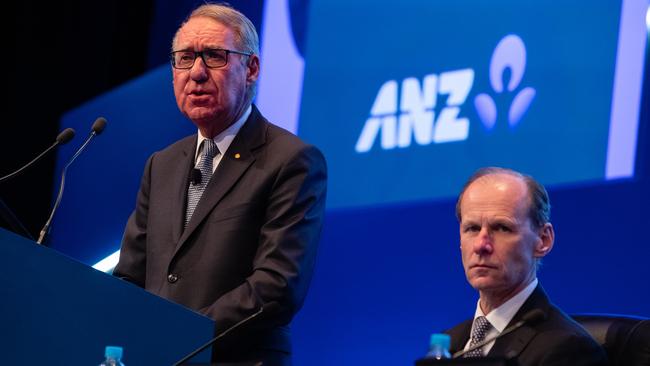ANZ holds its ground despite first strike
ANZ has stopped short of flagging any sweeping changes to its pay structure.

ANZ Bank stopped short of flagging any sweeping changes to its pay structure yesterday, despite joining two of its big four rivals in being stung by a landmark first strike against its 2018 remuneration report.
At the bank’s annual meeting in Perth, investors delivered the David Gonski-led ANZ board a much smaller rebuke than that served up to National Australia Bank and Westpac.
ANZ revealed 33.8 per cent of shareholders voted against the remuneration report at the meeting, surpassing the 25 per cent required for a strike. ANZ board member Paula Dwyer — who is chairman of Healthscope and Tabcorp — survived a strong protest vote of 27.1 per cent that was lodged against her re-election.
All of the big four banks have now taken a whack against remuneration in recent years, with Commonwealth Bank slapped by a wave of investor anger two years ago when almost 51 per cent of shareholders voted against its remuneration report. However, it has avoided any further strikes since then.
Mr Gonski told investors the bank was “looking at the question” of its pay structures but didn’t commit to any change.
“The board acknowledges the very real concerns of those who have voted against the report and I assure you we will continue to work hard in 2019 to ensure further alignment between compensation and shareholder interests,” he said.
“We have been making changes to remuneration for some years, including significantly reducing the compensation paid across the group.”
The banks are under fire given the string of scandals uncovered at the Hayne royal commission and as investors demand executives face more accountability for the failings.
Mr Gonski also got non-executive director and chairwoman of the human resources committee Ilana Atlas to front shareholders.
She defended the bank’s practices and incentive hurdles saying executives had seen a “meaningful and appropriate” reduction in pay after the royal commission hearings.
Chief executive Shayne Elliott had the granting of his performance rights easily approved with almost 95 per cent of investors giving the green light.
Mr Elliott also responded to questions about the departure of ANZ head of Australia Fred Ohlsson on a career break.
He told investors ANZ was reviewing the structure of the Australian unit and would announce changes in the weeks after an executive meeting in February.
“What I’ve decided with the board’s approval is to take this opportunity, given the amount of change and the headwinds we see in the Australian marketplace, just to step back a little bit and reflect on what’s the best way that we can organise, and lead the changes that are required for us to be successful in the future,” Mr Elliott added.
While he did not directly address changes by the prudential regulator to scrap lending limits on interest-only loans, Mr Elliott told investors after the relaxed rules were announced that he still expected to see “strong headwinds” in the housing market in the year ahead.
“Borrowing capacity has reduced and investor lending across the country has stalled,” he said.
“We don’t see these trends changing any time soon.”
ANZ didn’t give away much information, though, on the pending sale of its pensions and investments business to IOOF, which is being pursued by the prudential regulator in court.
“In terms of the IOOF transaction, we saw the announcement that came out a few days ago, we are working through that and we are trying to understand that,” finance chief Michelle Jablko said.
Serious questions about the transaction have been raised ahead of an ANZ trustee board having to vote on whether the deal is in the best interests of members. ANZ has already sold its financial planner dealer groups to IOOF, but the second part of the transaction is yet to complete.
APRA came out swinging and is seeking to ban four IOOF executives and its chairman George Venardos from superannuation companies. Mr Venardos stood aside from his role along with chief executive Chris Kelaher while the court action plays out.
Mr Gonski didn’t want to comment on the competition regulator’s cartel action against the bank and former treasurer Rick Moscati except to say he believed the executive had an “excellent case” to defend the action.
Mr Gonski said while ANZ couldn’t rule out finding more wrongdoing or failings in its assessment of potential remediation, in its last financial year 229 employees left the bank as a result of disciplinary action. That includes as a result of matters raised by the royal commission.
“I want to assure you, we at ANZ are not waiting for the commission’s final report before taking action,” Mr Gonski said.
“We acknowledged directly to the commission the situations where we believe our conduct has not lived up to the standard expected of us.
“We have taken steps to acknowledge accountability, including the reduction of executive remuneration, and we have sped up efforts to compensate customers. The commission’s interim report only strengthened our resolve to make ANZ simpler and better able to serve our customers.”



To join the conversation, please log in. Don't have an account? Register
Join the conversation, you are commenting as Logout